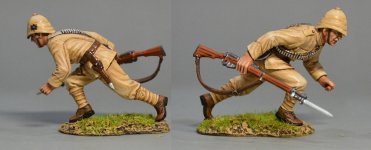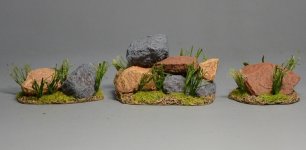TeamMiniatures
Private 1st Class
- Joined
- Oct 21, 2019
- Messages
- 177
The Second Boer War (11 October 1899 31 May 1902) was fought between the British Empire and two Boer states, the South African Republic (Republic of Transvaal) and the Orange Free State, over the Empire's influence in South Africa;To Afrikaners, also called Second War of Independence. It is also known variously as the Boer War, Anglo-Boer War, or South African War. Initial Boer attacks were successful, and although British reinforcements later reversed these, the war continued for years with Boer guerrilla warfare, until harsh British counter-measures brought the Boers to terms.
The Boers were dressed in their everyday farming clothes, which were a neutral or earth tone khaki color. Other significant advantages to the Boers included their widespread adoption of the breech loading rifle, which could be aimed, fired, and reloaded from a prone position, and the Boers' unconventional military tactics, which relied more on stealth and speed than discipline and formation.
Although it was the largest and most costly war in which the British engaged between the Napoleonic Wars and World War I (spending more than £200 million), it was fought between wholly unequal protagonists. The total British military strength in Southern Africa reached nearly 500,000 men, whereas the Boers could muster no more than about 88,000. But the British were fighting in a hostile country over difficult terrain, with long lines of communications, while the Boers, mainly on the defensive, were able to use modern rifle fire to good effect at a time when attacking forces had no means of overcoming it. The conflict provided a foretaste of warfare fought with breach-loading rifles and machine guns, with the advantage to the defenders, that was to characterize World War I.
The war ended when the Boer leadership surrendered and accepted British terms with the Treaty of Vereeniging in May 1902. Both former republics were incorporated into the Union of South Africa in 1910, as part of the British Empire.View attachment 258151View attachment 258152View attachment 258153View attachment 258155
The Boers were dressed in their everyday farming clothes, which were a neutral or earth tone khaki color. Other significant advantages to the Boers included their widespread adoption of the breech loading rifle, which could be aimed, fired, and reloaded from a prone position, and the Boers' unconventional military tactics, which relied more on stealth and speed than discipline and formation.
Although it was the largest and most costly war in which the British engaged between the Napoleonic Wars and World War I (spending more than £200 million), it was fought between wholly unequal protagonists. The total British military strength in Southern Africa reached nearly 500,000 men, whereas the Boers could muster no more than about 88,000. But the British were fighting in a hostile country over difficult terrain, with long lines of communications, while the Boers, mainly on the defensive, were able to use modern rifle fire to good effect at a time when attacking forces had no means of overcoming it. The conflict provided a foretaste of warfare fought with breach-loading rifles and machine guns, with the advantage to the defenders, that was to characterize World War I.
The war ended when the Boer leadership surrendered and accepted British terms with the Treaty of Vereeniging in May 1902. Both former republics were incorporated into the Union of South Africa in 1910, as part of the British Empire.View attachment 258151View attachment 258152View attachment 258153View attachment 258155









